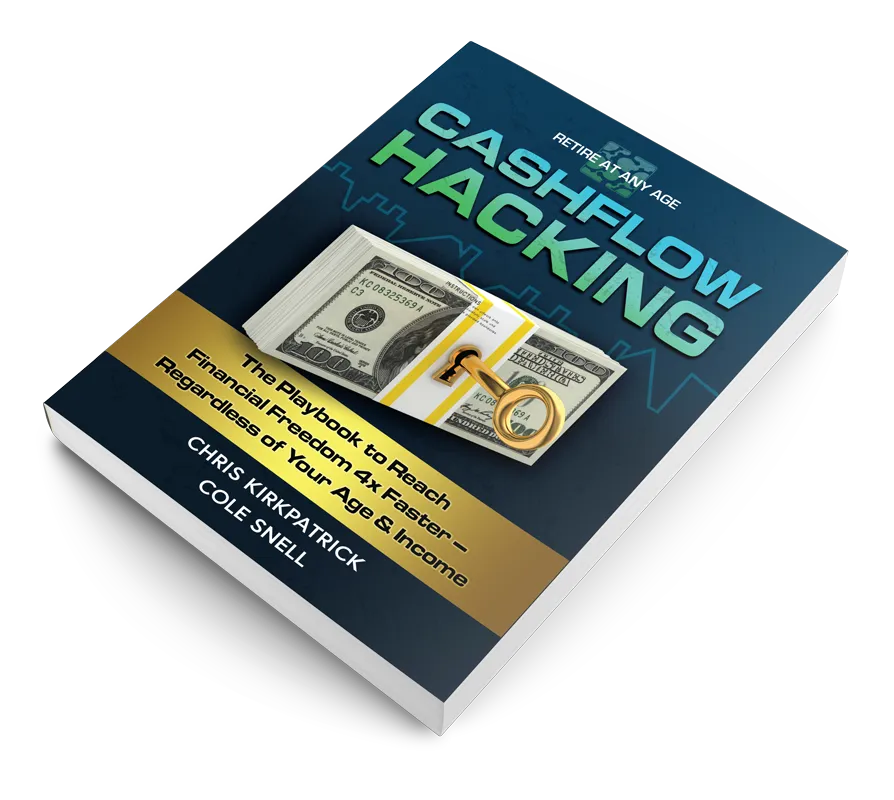
Simplifying Financial Confusion
LEARN CASH FLOW HACKING TO REACH FINANCIAL FREEDOM
Used by 90% of millionaires to reach their financial goals 4x faster

Achieve Financial Freedom Through Cash Flow Hacking

Increase Your Lifestyle While You Build Your Wealth

Position Yourself to Thrive in Market Downturn
YOU SHOULD NOT FEEL OUT OF CONTROL ABOUT YOUR FINANCIAL STRATEGY

Have easy access to your money in case of emergencies and opportunities

Use the investment strategy 90% of millionaires use

You deserve a clear plan to consistently grow your money and avoid market uncertainty

Have a guide and advisor that has your best interest in mind

Do not overpay in taxes

Stop guessing at the best vehicles to protect and grow your money

Exposed: The Whole Life Insurance Myths That Cost You Money
The present article is a written adaptation of the video available on the LIFE180 YouTube channel.
As someone who frequently engages with content on YouTube, TikTok, and Instagram, defending whole life insurance, I found it intriguing to create an article discussing the good, the bad, and the ugly aspects of life insurance, particularly whole life insurance. I want to shed light on some of the misconceptions prevalent in the whole life insurance space.
While figures like Dave Ramsey and Suze Orman are known for their criticism of whole life insurance, it's essential to acknowledge that there are advocates who might not represent it accurately on the other end of the spectrum.
In this article, my focus is to share five common misconceptions about whole life insurance that are not accurate, misleading, and contribute to a misunderstanding of what life insurance is truly about. After careful consideration, I've identified the top five misconceptions that I frequently encounter on both sides of the argument.
Introduction To Whole Life Insurance Myths
We're delving into the realm of whole life insurance and unraveling five common misconceptions that circulate on YouTube, social media, and across various online platforms. Before we dive in, it's essential to note that I've created in-depth videos exploring each of these topics.
However, the purpose of this article is not to conduct an exhaustive analysis of each concept or problem. Instead, it aims to shed light on the prevalent miscategorizations and misrepresentations of whole life insurance found on both ends of the spectrum.
The intent here is to expose you to these misconceptions, offering a glimpse into the challenges and controversies surrounding whole life insurance. For those seeking a more detailed exploration, I've compiled a playlist delving deeper into the power of whole life insurance.
You'll find a range of videos covering each aspect, allowing you to navigate through the nuances and gain a more comprehensive understanding. Feel free to explore the playlist at your own pace, diving into the specifics that intrigue you the most. The power of whole life insurance - Playlist
LIE 1 - Whole Life Insurance Is A Great or Bad Investment
Alright, the first assertion we often encounter is that whole life insurance stands as a superior investment alternative. Within the financial landscape, there are diverse opinions, with enthusiasts advocating its merits and critics, such as those in the Dave Ramsey or Suze Orman camps, vehemently denouncing it as a poor investment choice. The crux of the matter, however, lies in dispelling the notion that whole life insurance is an investment at all; in reality, it functions as a savings alternative.
Let's break it down. Properly assessing an asset involves categorizing it based on its associated risk. When considering the difference between saving and investing, it boils down to the level of risk involved. Investments expose you to market risks, where losses are a possibility. On the other hand, savings demand liquidity, accessibility, control, and guarantees – the primary intent being to safeguard against any potential loss. This is where whole life insurance excels – it serves as an excellent savings alternative.
If we view whole life insurance through the lens of savings, its purpose becomes clearer. The question arises: why save money? The answer lies in the need for an emergency fund or an opportunity fund, perhaps for future real estate ventures or business investments. Where should one stow away these funds? The answer is in assets devoid of excessive risks, uncertainties, and volatile returns. Whole life insurance, when properly designed, fulfills this need by providing liquidity for both emergencies and opportunities.
Therefore, it's crucial to emphasize that whole life insurance is not an investment but a savings alternative. Those who claim otherwise are misguiding. And with this, let's delve into the second point.
LIE 2 - Whole Life Insurance Premiums Are NOT Flexible
The flexibility of whole life insurance premiums goes beyond common perceptions. This flexibility holds significant importance, especially considering our recent discussion on the role of whole life insurance in housing an emergency fund. Personally, I strongly advocate for the establishment of an emergency fund, and I firmly believe that a whole life policy provides the optimal environment for safeguarding these funds.
For those skeptical about the concept of an emergency fund, concerns often center around the fear of a substantial cash outlay in the event of job loss or financial hardship. However, when a whole life policy is appropriately designed, it offers a remarkable level of flexibility. This adaptability becomes crucial in helping you navigate the challenges of unemployment or a temporary lack of income without being constrained by rigid payment structures.
Consider the following example: Imagine you are annually contributing $10,000 to your policy, earmarking it for your emergency fund or future savings. This $10,000 is comprised of both a fixed and a flexible component. The base, representing your annual obligation, remains relatively rigid. However, the paid-up additions, a key element in many situations, provide the desired flexibility.
This flexibility allows you to make adjustments to the flexible portion of your premium during challenging times, enabling you to adapt to changes in your financial circumstances. Even if your income takes a temporary hit, a properly designed whole life insurance policy can offer the adaptability needed to ride out the waves of unemployment or a lack of income.
Understanding the inherent flexibility in whole life insurance premiums is crucial to maximizing the benefits of such policies, especially when considering them as a secure repository for your emergency fund.
The challenge lies in the variations among different insurance companies, each with its own set of rules and levels of flexibility regarding paid-up additions. When people ask me about the best blend and design of a policy, my response is consistently rooted in tailoring it to their individual needs. What I emphasize is that the inherent flexibility embedded in these policies is one of the most critical factors to consider.
While renowned companies like Mass Mutual, Northwestern, and New York Life are reputable, the challenge often lies in the limited flexibility associated with their paid-up additions. In cases where financial setbacks occur, such as job loss leading to reduced cash flow, these companies may not provide the necessary flexibility. If you find yourself unable to fund the paid-up additions for a certain period, it could impact your ability to resume contributions in the future.
Understanding your goals, objectives, and the potential risks is paramount. It's crucial to assess both the upside and downside of the policy, especially considering the worst-case scenario: losing your job and being unable to pay the premium. If you can't articulate a solid plan for managing the policy during tough times and ensuring its stability when your financial situation improves, it may indicate that the chosen policy might not be the right fit.
Contrary to the common misconception that whole life insurance lacks flexibility, it can be highly flexible when aligned with the right company and a policy design that caters to your specific needs. The key is to thoroughly assess your circumstances and choose a policy that not only serves your immediate financial goals but also offers the adaptability needed to weather unforeseen challenges.
LIE 3 - The Whole Life Insurance Keeps Your Cash Value When You Die
The third point revolves around Dave Ramsey's consistent assertion that people should avoid purchasing life insurance because it is considered a poor investment due to the life insurance company retaining the cash value when the policyholder passes away. That's his perspective.
Delving into it, let's say you have a premium, cash value and death benefit. To illustrate, suppose your premium is $10,000. Imagine having a $400,000 death benefit. Let's assume you choose the right company, implement the correct strategy, and end up with, for example, $8,000 in cash value in the first year.
Now, discuss the nature of paid-up additions. As you make annual payments, let's assume it's $10,000 per year, resulting in a total premium of $100,000. I may be a bit off on the numbers, but let's consider this scenario where the total grows to $110,000. This growth is attributed to the increase in your cash value every single year. In this particular situation, suppose the death benefit also rose to $510,000. My estimate is it might actually be $520,000 or potentially even more, but for the sake of this discussion, let's stick with the given figures.
Let's break down Dave Ramsey's advice on whole life insurance. According to him, avoiding paid-up additions and sticking to the basic blend is key. In this scenario, he envisions the cash value growing from zero to, let's say, $110,000, accompanied by a $400,000 death benefit.
However, Ramsey's criticism lies in the fact that, with this approach, you're only guaranteed the $400,000 death benefit, not the additional $110,000. The issue intensifies when considering that the initial growth phase from zero to $110,000 often takes several years. Realistically, by year 10, you might not even reach $110,000; you could be closer to $70,000 or so.
In essence, when we reach year 10, it becomes evident that we are not following the approach Dave Ramsey strongly opposes. This is where the significance of policy design comes into play.
Considering the alternative, you could redirect your premium elsewhere instead of saving it in whole life insurance. This alternative approach allows for the creation of more leverage. It's essential to note that along with this strategy, you gain access to living benefits. These benefits hold particular importance for medical directive control.
In the unfortunate event of critical, chronic, or terminal illness, you retain the ability to access your death benefit while still alive. This provision proves invaluable for covering the costs of alternative treatments, addressing issues such as cancer and other serious ailments.
If this scenario unfolds, where your death benefit increases by $110,000 alongside your cash value, let's understand the dynamics. The life insurance company retains the cash value, intending to later distribute it to you as a tax-free death benefit.
Consider reframing the concept: instead of labeling it as cash value, think of it as a savings account. Notably, a conventional savings account incurs a tax liability as it grows each year. In contrast, with whole life insurance, the growth is tax-free, providing tax-free access.
Moreover, an alternative approach could involve opting for a $400,000 death benefit instead of the expanded $510,000. This choice allows for a $400,000 tax-free benefit, and the remaining $110,000 could be held in a tax-free savings account. Alternatively, one could consider purchasing a term life insurance policy for $400,000, ensuring the tax-free status of the initial benefit. However, it's crucial to note that the additional $110,000 would be subject to taxation for you or your heirs.
This explains why they allocate the $110,000 in this manner. The life insurance company retains the $110,000, intending to distribute it through the death benefit. There are various approaches to achieve this, emphasizing the importance of policy design in determining the most effective strategy.
LIE 4 - You Never Have To Pay Your Whole Life Insurance Policy Loans Back
The fourth misconception often circulated is the notion that you never have to repay your loans. I grasp the context surrounding this claim, and it's precisely one of the reasons I harbor skepticism, especially towards online marketing in the life insurance domain. The abundance of misleading information and the clickbait nature of such statements make it a concerning trend.
Recently, during a meeting with a person, a situation led me to consider adding a bonus misconception, which I'll label as lie number six. This encounter served as a reminder of the misinformation prevalent in the industry. I'll delve into this additional point shortly.
However, it's essential to clarify a commonly misinterpreted aspect of a whole life insurance policy: the idea that you never have to repay your policy loans. This is often misrepresented, especially when discussed by influencers. Such statements tend to attract individuals seeking immediate access to funds.
In reality, the scenario unfolds differently. If your policy grows and matures, and you decide to take a policy loan after a substantial period, say 10 to 15 years, there's a possibility that you may never have to repay that policy loan.
This is where the strength of whole life insurance shines – utilizing withdrawals up to basis and subsequently taking loans can serve as an effective volatility buffer. This strategy proves valuable, acting as a robust element in retirement income planning. Leveraging loans in this manner can indeed form an exceptional approach.
However, a common misconception arises when individuals believe they can acquire a policy in the first year, borrow against it without repayment, perhaps repeating the process in years one, two, three, or four without any obligation to repay. The reality is, if you neglect to repay these loans, it may pose a significant issue in the future. Taking a loan early in the policy and failing to repay it can have repercussions that catch up with you down the line.
Nelson Nash emphasizes the need to treat oneself as a responsible banker. If you would repay a banker, then treat yourself with the same diligence. Don't take a loan against your policy if you're not prepared to handle it like any other regular loan.
This principle is a driving force behind my strategy, Cashflow Hacking. It aims to shift the conversation away from using the policy for depreciating assets like cars and redirect focus towards cash flow-producing assets. These assets can seamlessly contribute to sustaining your system and effectively manage policy loans independently.
This strategy not only embraces the flexibility and the unstructured nature of policy loans but also creates a compelling scenario. It becomes particularly fascinating when you amalgamate the strength of whole life insurance, concentrating on leveraging and accelerating the performance of cash flow-producing assets, such as real estate generating consistent cash flow.
LIE 5 - Whole Life Insurance Doesn't Have Living Benefits
Now, before delving into the bonus point, let's address the fifth misconception. I may have hinted at it earlier when discussing living benefits. One significant reason why I'm critical of the 'buy term and invest the difference' concept is its overly short-term perspective.
Dave Ramsey often advocates the idea that you don't need insurance as you age if you diligently follow his plan. According to him, if you save enough, invest in mutual funds yielding a delusional 12% annually, and reach retirement, you could be in a position to self-insure. The flaw in this perspective lies in overlooking the array of living benefits that whole life insurance provides.
Without whole life insurance, you miss out on the potential of using it as a volatility buffer in retirement, enhancing the performance of your other investments, and having a safety net if you face critical health conditions like cancer, Alzheimer's, or any mental dementia. The ability to accelerate your death benefit tax-free allows you to control your medical directives and pursue the treatments you desire, rather than being dictated by insurance companies. This, to me, is an immensely powerful aspect of whole life insurance in retirement.
(BONUS) LIE 6 - You Can Borrow Against The Death Benefit Of Your Whole Life Insurance Policy
Moving on to the sixth bonus topic, and quite surprisingly, it's an aspect that holds significant weight, perhaps even deserving to be placed at the top of the list. This perspective challenges the proponents of whole life insurance, emphasizing the importance of language and the impact it can have.
The reason I dislike this is because it confuses people. I had a conversation about this the other day. I drove up to North Scottsdale and discussed it with a genuinely good person who was considering purchasing a policy.
He was eager to proceed with it because he thought, “If I put $50,000 in this policy and get a million dollars, I need to get this going now for some leverage.” Curious, I asked, “Do you mean you want to take a policy loan?” He responded affirmatively. I explained, “Alright, we need to design your policy to ensure the cash value is available.” However, he mentioned, “But I've been reading online and watching videos that say you borrow against your death benefit.” I clarified, “Yes, the insurance company guarantees your loan against the death benefit, but you don't directly borrow against the death benefit itself.” Despite my explanation, he insisted, “No, people are saying you borrow against the death benefit”.
So he, and I know I have this conversation a lot, thinks and thought until I had this conversation to help straighten him out, thought that if he had a million dollars, he could borrow a certain percentage of that million dollars.
And that was his borrowing capacity; he believed it was the million dollars of insurance because people online are saying you borrow the insurance company and let you borrow against the death benefit. No, you don't borrow against the death benefit; you borrow against your cash value, and the insurance company guarantees that loan against the death benefit. There's a wild difference there.
You cannot leverage and borrow against the policy more than you've put in. That would just be too risky, and these insurance companies would be too susceptible to too much volatility, too much risk, and it would make no sense.
So, those are the six things that I see miscategorized about whole life insurance that I think everybody should understand more in-depth. If you are looking to gain a deeper understanding of whole life insurance in general, I encourage you to watch The Power of Whole Life Insurance - Playlist. I believe it's around 60 videos long. However, you can open the playlist, go through the videos, and find the ones that are most relevant to you and your current needs and interests.
Should you wish to connect with somebody, go down below, click on this schedule clarity call with one of the people on my team. We'd be happy to help you out. It's a no-pressure, no sales pitch conversation, just really looking to help you gain clarity about how this stuff could look in your life. If it makes sense, we'll work together. If not, no harm, no foul. Best of luck to you.
If you found value in this, please like it, share it, and get it out there to people. Visit my LIFE180 Youtube Channel and subscribe, hit the bell so you're notified every time I launch a new video because we've got videos like these coming out all the time. Until next time, have a blessed and inspirational day. We'll talk soon.
HOW TO START TAKING CONTROL OF YOUR FINANCES BY MAXIMIZING YOUR CASH FLOW AND PROTECTING YOUR ASSETS

1. Schedule Your Free Clarity Call

2. Create a Free Customized Plan

3. Get Guide to Financial Success
GET YOUR FREE COPY TO STOP USING OUTDATED RETIREMENT STRATEGIES
Cash Flow Hacking teaches you to:
Protect Your Investments
Thrive in bad markets
Reach financial freedom faster

ARE YOU LOOKING FOR:

Cash Flow Hacking teaches you to:
Security to protect your money
Increased cash flow and lifestyle
Inflation protection
Financial certainty in all economic environments
A reduction in taxes
Safe and fast access to your money with no penalties
WHO IS THIS PROGRAM FOR?

People looking for an alternative
Are you looking for alternatives to Wall Street’s “buy and hold” strategy that takes 40 years with uncertain results? Our Cash Flow Hacking strategies provide you the building blocks to get started on the right foot

Passionate Entrepreneurs
Are you looking for a financial strategy that will take your best assets (you and your businesses) and multiply their potential? Our Cash Flow hacking strategies will teach you how to invest for the future without sacrificing building your business

Real Estate
Investors
Are you a real estate investor who is burned out from being a landlord or playing the fix-and-flip game? Our Cash Flow Hacking strategies will provide you with the system to create predictable wealth AND give you the freedom you are looking for.
YOU DESERVE PEACE OF MIND AND A PLAN THAT WILL PROTECT YOUR FAMILY AND GROW YOUR WEALTH
Today you need to be more savvy than ever if you try to go at it alone.
Losing money to inflation, taxes, and just poor investment strategies is leaving you frustrated, feeling out of control and not knowing where to turn. To add to the problem, the market is flooded with advisors who have outdated advice that does not place your best interests first, but instead focuses on charging you a fee that creates guaranteed cash flow for them.
NOT YOU
We believe this is wrong and that your security and best interests should be placed first. We believe you should be in a position where you control your money, your money doesn't control you. We understand because we talk with hardworking people everyday that are losing money in the markets based on old information and feel like they are guessing at the best course of action.
We created the Cash Flow Hacking plan to help you have security and control of your money to take advantage of life's opportunities because you deserve peace of mind with your wealth. The old way of planning for retirement of… Go to school Get a job & save as much as you can in your 401k and mutual funds...is broken.
You have been lied to. Think about it, where else in life does someone tell you that the most certain way to achieve your desired result is to take on more risk? The math just doesn't work, and the results are showing in our country and world. Did you know that 90% of millionaires in the United States have 1 asset in common?
Hint: it's not stocks or mutual funds (and no...it's not crypto) How much sense does it make for you to work hard, save money, reduce your current lifestyle (because that's what you are doing when you save for the future - taking money you could use on lifestyle today and delaying gratification to a future unknown time), and hope that whatever you are doing will work three to four decades from now? If you're thinking, "not much sense at all…", you are in the right place.
With over 50 years of experience on our team, we have worked with thousands of individuals and families to achieve financial freedom faster and with more predictability by helping them invest for Cash Flow.
How does the Cash Flow Hacking Plan work? 1. Take the Cash Flow Hacking Challenge 2. Complete the LIFE180 X-Ray and determine what your Freedom Number is 3. Work with a Cash Flow Hacking expert to provide you a customized plan
The customized Cash Flow Hacking plan will give you clarity on where you are now, where you want to go (and in what time frame), and what you need to do to get there predictably.
We value and commit to you: We believe you deserve the best financial education and guidance We believe financial decisions should not be rushed but be well thought out with a plan We believe you should be in control of your money We believe we earn your trust through time, education, and proper due diligence Without a proper plan and guidance, your money can be lost to taxes, inflation, and bad investments You deserve more with the most up-to-date strategies to mitigate your risk, control your money, and earn stable returns regardless of the market Schedule a call here to attain your LIFE180 Financial X-Ray now or get started with the Cash Flow Hacking Challenge for free.
I am interested in...